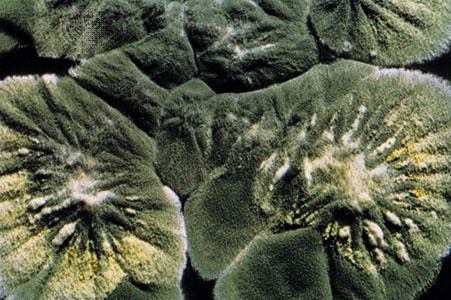penicillin
drug
one of the first and still one of the most widely used antibiotic agents, derived from the Penicillium mold. In 1928 Scottish bacteriologist Alexander Fleming (Fleming, Sir Alexander) first observed that colonies of the bacterium (bacteria) Staphylococcus aureus failed to grow in those areas of a culture that had been accidentally contaminated by the green mold Penicillium notatum. He isolated the mold, grew it in a fluid medium, and found that it produced a substance capable of killing many of the common bacteria that infect humans. Australian pathologist Howard Florey (Florey, Howard Walter Florey, Baron) and British biochemist Ernst Boris Chain (Chain, Sir Ernst Boris) isolated and purified penicillin in the late 1930s, and by 1941 an injectable form of the drug was available for therapeutic use.
 The several kinds of penicillin synthesized by various species of the mold Penicillium may be divided into two classes: the naturally occurring penicillins (those formed during the process of mold fermentation) and the semisynthetic penicillins (those in which the structure of a chemical substance—6-aminopenicillanic acid—found in all penicillins is altered in various ways). Because it is possible to change the characteristics of the antibiotic, different types of penicillin are produced for different therapeutic purposes. Penicillin G is the only naturally occurring penicillin that is still used clinically. Because of its poor stability in acid, much of penicillin G is broken down as it passes through the stomach; as a result of this characteristic, it must be given by intramuscular injection, which limits its usefulness. Some of the semisynthetic penicillins are more acid-stable and thus may be given as oral medication.
The several kinds of penicillin synthesized by various species of the mold Penicillium may be divided into two classes: the naturally occurring penicillins (those formed during the process of mold fermentation) and the semisynthetic penicillins (those in which the structure of a chemical substance—6-aminopenicillanic acid—found in all penicillins is altered in various ways). Because it is possible to change the characteristics of the antibiotic, different types of penicillin are produced for different therapeutic purposes. Penicillin G is the only naturally occurring penicillin that is still used clinically. Because of its poor stability in acid, much of penicillin G is broken down as it passes through the stomach; as a result of this characteristic, it must be given by intramuscular injection, which limits its usefulness. Some of the semisynthetic penicillins are more acid-stable and thus may be given as oral medication.All penicillins work in the same way—namely, by inhibiting the bacterial enzymes responsible for cell wall synthesis and by activating other enzymes to break down the protective wall of the microorganism. Therefore, they are not effective against microorganisms that do not produce cell walls.
Some strains of previously susceptible bacteria, such as Staphylococcus, have developed a specific resistance to the naturally occurring penicillins; these bacteria either produce β-lactamase (penicillinase), an enzyme that disrupts the internal structure of penicillin and thus destroys the antimicrobial action of the drug, or they lack cell wall receptors for penicillin, greatly reducing the ability of the drug to enter bacterial cells. This has led to the production of the penicillinase-resistant penicillins.
Penicillins are used in the treatment of throat infections, meningitis, syphilis, and various other infections. The chief side effects of penicillin are hypersensitivity reactions, including skin rash, hives, swelling, and anaphylaxis, or allergic shock. The more serious reactions are uncommon. Milder symptoms may be treated with corticosteroids but usually are prevented by switching to alternative antibiotics. Anaphylactic shock, which can occur in previously sensitized individuals within seconds or minutes, may require immediate administration of epinephrine (epinephrine and norepinephrine).
- Baldwin V
- Baldy Mountain
- Balearic Islands
- baleen whale
- Bale, John
- Balenciaga, Cristóbal
- baler
- Bales, Peter
- Balewa, Sir Abubakar Tafawa
- Balfe, Michael William
- Balfour, Arthur James Balfour, 1st earl of, Viscount Traprain
- Balfour Declaration
- Balfour, Francis Maitland
- Balfour, Robert
- Balfour, Sir James
- Balfour Stewart
- Bal Gangadhar Tilak
- Bali
- Balikpapan
- Balinese
- Balkan Entente
- Balkanization
- Balkan League
- Balkan Mountains
- Balkans